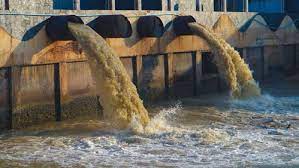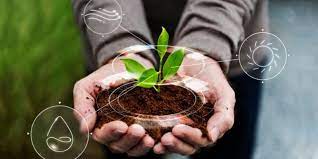Heavy Metal Contamination in Water
Heavy metals are found widely in the earth’s crust and are non- biodegradable in nature. They enter into the human body via air, water and food. A small number have an essential role in the metabolism of humans and animals in very trace amounts but their higher concentration may cause toxicity and health hazards.
The hazardous nature of heavy metals has been recognized because of their bioaccumulative nature in biotic systems. They can enter into the environment through mining activities, industrial discharge and from household applications, into nearby bodies of water (Gautam etal., 2014).
Other sources of environmental contamination by heavy metals include atmospheric deposition, fertilizer, pesticide application and nuclear waste (Ojo, 2017).
Heavy Metals Contamination in Water
Heavy metals from the mining, agricultural runoffs, industrial sources are leached into the underground water , moving along water pathways and eventually depositing in aquifer or are washed away by runoffs into surface water, resulting in water pollution.
For example, the sources of heavy metals (such as As, Cd, Hg, Pb, Cr and Zn) contamination in Port Klagn in Malaysia were industrial wastewater and port activities, where water was collected from 21 stations at 3 months intervals and contamination factor (Cf) and contamination degree (Cd) were calculated to estimate the contamination status at the sampling areas (Sany et al., 2013).
Wu et al. (2015) indicated that there has been contamination of pond water and soil from illegal e-waste recycling activity. The presence of heavy metals such as Pb, Cd, Cu, Mo, Ni and Cr in drinking water in some Great Cairo Cities in Egypt has been linked to the occurrence of certain diseases such as renal failure, liver cirrhosis, hair loss, and chronic anemia (Salem etal., 2000).
Physio chemical Remediation Processes and Applications
The common physicochemical treatment processes for metal remediation in water include: chemical precipitation, ion exchange and reverse osmosis.
Chemical precipitation
This is a widely practiced technology for the removal of heavy metals from water. It has long been the primary method of treating metal-laden industrial wastewater (Akpor and Muchie, 2010).
This process involves the transformation of dissolved contaminants into insoluble solids, thereby facilitating the contaminant’s subsequent removal from the liquid phase by physical methods, such as clarification and filtration.
In a precipitation process, chemical precipitants (also called coagulants and flocculants) are used to increase particle size through aggregation. The amount of chemical required during treatment depends on pH and alkalinity of the water.
As a rule, heavy metals in water are precipitated by adding sodium hydroxide or lime during neutralization. However, the results of this process are far from being satisfactory in many instances as complete hydroxide precipitation does not take place especially in the presence of complexing agents (Xu and Xu, 2008).
A combination of precipitation with other chemical treatment techniques, such as ion exchange has been reported to be effective in heavy metal removal in polluted waters.
In South Africa, acid mine water from gold mine has been treated by the precipitation of heavy metals with lime and sulphides, followed by ion exchange.
The process was reported to generate very pure water from acid mine water with a great flexibility and an acceptable cost (Akpor and Muchie, 2010).
Chemical precipitation of metals can be justified by their low costs and can be performed by a simple pH adjustment. Other advantages include:
It is a well-established technology with ready availability of equipment and chemicals. Being a completely enclosed system, it is convenient, self- operating and requires low maintenance since only replenishment of chemicals is needed with no need for sophisticated operators.
In spite of the above advantages, chemical precipitation of metals in water still has the following disadvantages:
The precipitates are in the form of light tiny flocs requiring an extra coagulation/flocculation.

Large volumes of sludge are generated, inducing additional waste-disposal costs. The addition of treatment chemicals may increase the waste sludge up to 50% (EPA, 2000).
Regulation requirements are not always met using hydroxide and carbonate precipitation alone. Each dissolved metal has its own distinct pH level for maximum hydroxide precipitation.
Read Also : Transport of Pesticides in Surface Waters
Because metal hydroxides are increasingly soluble above or below their maximum precipitation point, even a slight pH adjustment to precipitate one metal may put another back into solution.
It requires working with corrosive chemicals, thereby increasing safety concerns (EPA, 2000).
Ion exchange
Ion exchange is a reversible chemical reaction wherein an ion from water or wastewater solution is exchanged for a similarly charged ion attached to an immobile solid particle.
These solid ion exchange particles are either naturally inorganic zeolites or synthetically produced organic resins. It is a process that is very similar to biosorption whereby the latter is known to actually function predominantly on the basis of ion exchange.
Ion exchange employs mainly hydrocarbon-derived polymeric resins (Volesky etal., 2003). This technique has been successfully used in the removal of heavy metals from water.
Reverse osmosis
Reverse osmosis is a membrane process acting as a molecular filter to remove over 99% of all dissolved minerals. In this process, water passes through the membrane while the dissolved and particulate matter is left behind.
The process is very effective for removal of ionic species from solution. The resulting concentrated by-product solutions make eventual recovery of metals more feasible.
In spite of the effectiveness, the membranes are relatively costly to procure and operate. The use of elevated pressures makes this technique expensive and sensitive to operating conditions.
A significant advantage of reverse osmosis over other traditional water treatment technologies is the ability to reduce the concentration of other ionic contaminants, as well as dissolved organic compounds (Volesky etal., 2003; Pawlak et al., 2005). Reverse osmosis had been applied in heavy metal removal both in small and large scales.
Phytoremediation Processesa nd Applications
Phytoremediation is a remediation process that entails the use of plants to partially or substantially remediate selected substances in contaminated soil, sludge, sediment, groundwater, surface water and wastewater. It is also called green remediation, botano-remediation, agro-remediation or vegetative remediation.
Based on the type of contaminant and underlying process, phytoremediation is broadly categorized into the following main areas: phytodegradation/phytotransformation, phytoaccumulation, phytoextraction, phytostimulation/rhizostimulation, phytovolatilization, rhizofiltration and phytostabilization.
The removal of metal contaminants from water through Phytoremediation occurs by any of three mechanisms: phytoextraction, rhizofiltration and phytostabilization (Lasat, 2000; UNEP, 2010).
Phytodegradation
Phytodegradation is the breakdown of organic contaminants by internal and external metabolic processes driven by the plant. Its involves the use of plants to absorb, store and degrade contaminants within their tissues.
In the process, plants actually metabolize and destroy contaminants within their tissues. Some contaminants can be absorbed by the plant and are then broken down by enzymes (Newman and Reynolds, 2004).
During phytodegradation, the plants are able to take-up metal contaminants directly from soil water or release exudates that help to degrade pollutants through cometabolism in the rhizosphere.
For environmental application, it is important that the metabolites that accumulate in vegetation are non-toxic or at least significantly less toxic than the parent compound.
Phytoextraction
Phytoextraction is a phytoremediation process wherein plant roots take- up, translocate and store contaminants along with other nutrients and water. This method is used primarily for wastes containing metals. Because different plants have varying abilities to absorb and withstand high levels of pollutants, many different plants may be used.
Metal compounds that have been successfully phytoextracted include zinc, copper, and nickel, but there is promising research on the verge of completion on lead and chromium absorbing plants (Lasat, 2000; UNEP, 2010).
Phytostimulation
In this process, plants release natural substances through their roots, thereby supplying nutrients to microorganisms, which in turn enhance biological degradation. It is a symbiotic relationship between plants and microorganisms for the degradation of contaminants (Lasat, 2000).
During phytostimulation, there is the release of organic substances and oxygen by plant roots, which stimulates microbial activity in the rhizosphere compared to bulk soils.
This results in increased microbial activity, which in turn results in a stimulation of natural degradation of organic contaminants (Meers and Tack, 2004).
Rhizofiltration
This process is similar to phytofiltration, but the only difference is that the plants for remediation are raised in greenhouses with their roots in water. It is the breakdown of organic contaminants in water through enhanced microbial activity in the plant root zone or rhizosphere.
The process is concerned with the remediation of contaminated groundwater rather than the remediation of polluted soils. The contaminants are either adsorbed onto the root surface or are absorbed by the plant roots.
Plants used for this are not planted directly in situ but are first acclimated to the pollutant (Lasat, 2000). A suitable plant for rhizofiltration applications can remove toxic metals from solution over an extended period with its rapid-growth root system.
A variety of plant species have been found to be effective in removing toxic metals, such as Cu2+, Cd2+, Cr 6+, Ni2+, Pb2+ and Zn2+ from aqueous solutions.
Phytovolatilization
This process makes use of the ability of the plant to absorb contaminants from the growth matrix and subsequently transform and volatilize them into the atmosphere through its leaves.
The contaminant may become modified along the way, as the water travels along the plant’s vascular system from the roots to the leaves, whereby the contaminants evaporate or volatilize into the air surrounding the plant.
Some of these contaminants can pass through the plants to the leaves and volatilize into the atmosphere at comparatively low concentrations. The process of phytovolatilization depends heavily on the physical characteristics of the contaminant itself. Io order to get into the plant, the contaminant must have the proper chemistry to pass through the root membrane. Once inside the plant it can then be phytovolatilized into the atmosphere through the stomata.
Phytostabilization
Phytostabilization, also referred to as in-place inactivation, is primarily used for the remediation of soil, sediment, and sludges. It is the use of plant roots to limit contaminant mobility and bioavailabilty in the soil.
During the process, contaminants are absorbed onto the roots, or precipitated in the rhizosphere. When this happens, there is the prevention of mobility of the contaminants, hence reducing their availability in the food chain (Lasat, 2000).
The process of phytostabilization depends on the tolerance ability of a plant to a contaminant. Even if the plant physically remove little or no contaminant, they are useful as phytostabilization agents as long as they tolerate and grow under the contaminated conditions.
Phytoremediation has several advantages and disadvantages when compared to conventional remediation processes. Its advantages include:
Economical and low cost technology.
Less disruptive to the environment and does not involve waiting for new plant communities to decolonize the site.
No need for disposal sites, hence reducing risk of spread of contaminants.
More aesthetically pleasing than traditional methods.
Potential to treat sites polluted with more than one type of pollutant.
Dependent on the growing conditions (climate, geology, altitude, temperature) required by the plant, hence success depends on tolerance of the plant to the pollutant.
Requires access to agricultural equipment and knowledge to operate at large scale.
Risk of release of contaminants collected in senescing tissues being released back into the environment.
Contaminants may be collected in woody tissues used as fuel
Since it is dependent on plant growth, when compared to other technologies, remediation time is long.
Possibility for environmental damage due to leaching of soluble contaminants.
Read Also : Degradation and Types of Pesticides in Soils
Because of shallowness of plant roots, there is the problem of depth limitation, hence effectiveness can only be achieved within zone of influence of plant roots.
Microbial Remediation Processes and Applications
Microbial bioremediation is defined as the process by which microorganisms are stimulated to rapidly degrade hazardous organic contaminants to environmentally safe levels in soils, subsurface materials, water, sludge and residues.
Microbes deal with poisonous chemicals by applying enzymes to convert one chemical into another form and taking energy or utilizable matter from this process. The chemical transformations generally involve breaking of large molecules into several small molecules in simpler form.
Given the interest in water and wastewater treatment, the response of microorganisms towards toxixc heavy metals is of importance. In some cases the by-products of microbial remediation are not only harmless but may prove useful.
Microbial activity is considered to play a key role in the detoxification of metals in water. For example, wastewater treatment systems are known to rely on microbes to perform the function of the breakdown of sewage influent. The microbes live in the sludge of the treatment plants, digest the solids and breakdown various compounds.
Being living organisms, microbes require certain nutrients and environments to survive, multiply and perform. In any wastewater treatment system there is a vast array of microbes present, that is aerobic, anaerobic and facultative, each performing specific functions in their respective parts of the system.
Each of these microbial species has tolerance of ecological minimums and maximums with respect to various conditions, such as pH, temperature, dissolved oxygen levels and nutrient levels.
Microbial metal uptake can either occur actively (bioaccumulation) and/or passively (biosorption). Studies conducted in large-scale systems have shown that biosorptive processes are more applicable the bioaccumulative processes.
This is because living systems (active uptake) often require the addition of nutrients and hence increase biological oxygen demand or chemical oxygen demand in the effluent. On the contrary, biosorption is reported to be quite effective for the removal of metal ions from contaminated solution in low cost and environmental friendly manner.
Microbial remediation has several advantages and disadvantages. Its advantages include:
It uses relatively low-cost, low-technology techniques, hence requires moderate capital investment. It is fairly inexpensive when compared to other remediation processes.
It is environmentally safe since it is a natural process usually perceived by the public as an acceptable treatment process.
It does not generate waste, hence less wasted groundwater.
It is self-sustaining since the microbes able to degrade the contaminant increase in numbers when the contaminant is present; and decreases when the contaminant is degraded.
The residues for the treatment are usually harmless products and include carbon dioxide, water, and cell biomass.
It can be used alongside other technologies; and
It can be conducted on site, often without causing a major disruption of normal activities.
Some of the disadvantages are:
It is not always suitable, however, as the range of contaminants on which it is effective is limited, the time scales involved are relatively long, and the residual contaminant levels achievable may not always be appropriate.
Bioremediation is limited to those compounds that are biodegradable. Not all compounds are susceptible to rapid and complete degradation.
There are some concerns that the products of biodegradation may be more persistent or toxic than the parent compound.
Biological processes are often highly specific, since success is dependent on the presence of metabolically capable microbial populations, suitable environmental growth conditions, and appropriate levels of nutrients and contaminants.
It is difficult to extrapolate from bench and pilot-scale studies to full-scale field operations, for research is needed to develop and engineer bioremediation technologies that are appropriate for sites with complex mixtures of contaminants that are not evenly dispersed in the environment.
Although the methodologies employed are not technically complex, considerable experience and expertise may be required to design and implement a successful bioremediation program because of the need to thoroughly assess a site for suitability and to optimize conditions to achieve a satisfactory result (Akpor and Muchie, 2010).
In conclusion, heavy metal contamination of distributed water and discharged wastewater is a constant area of concern. There is the challenge to remediate hazardous metal-containing water and wastewater worldwide.
The removal of heavy metals from domestic and industrial waters has become an important application in water and wastewater treatment systems. This is because legislations and guidelines have created strict distribution and discharge limits, which has compelled plants to add or upgrade metal removal processes.
Currently, there is no single technology for heavy metal remediation (chemical remediation, phytoremediation or microbial remediation) that is devoid of some form of merits and demerits. Consequently, there is a need for the implementation of an integrated remediation technology capable of having great potential.
The common physicochemical treatment processes for metal remediation in water include: chemical precipitation, ion exchange and reverse osmosis;
Phytoremediation is a remediation process entailing the use of plants to partially or substantially remediate selected substances in contaminated soil, sludge, sediment, groundwater, surface water and wastewater.
Microbial bioremediation is a process by which microorganisms are stimulated to rapidly degrade hazardous organic contaminants to environmentally safe levels in soils, subsurface materials, water, sludge and residues.



